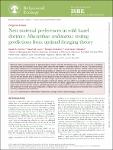Nest material preferences in wild hazel dormice Muscardinus avellanarius: testing predictions from optimal foraging theory
| dc.contributor.author | Collins, Sarah | |
| dc.contributor.author | Lane, Sarah | |
| dc.contributor.author | Ishibashi, M | |
| dc.contributor.author | Hamston, T | |
| dc.date.accessioned | 2023-04-17T10:51:30Z | |
| dc.date.available | 2023-04-17T10:51:30Z | |
| dc.date.issued | 2023-03-25 | |
| dc.identifier.issn | 1045-2249 | |
| dc.identifier.issn | 1465-7279 | |
| dc.identifier.uri | https://pearl.plymouth.ac.uk/handle/10026.1/20711 | |
| dc.description.abstract |
<jats:title>Abstract</jats:title><jats:p>Obtaining nesting material presents an optimal foraging problem, collection of materials incurs a cost in terms of risk of predation and energy spent and individuals must balance these costs with the benefits of using that material in the nest. The hazel dormouse, Muscardinus avellanarius is an endangered British mammal in which both sexes build nests. However, whether material used in their construction follows the predictions of optimal foraging theory is unknown. Here, we analyze the use of nesting materials in forty two breeding nests from six locations in Southwest England. Nests were characterized in terms of which plants were used, the relative amount of each plant, and how far away the nearest source was. We found that dormice exhibit a preference for plants closer to the nest, but that the distance they are prepared to travel depends on the plant species. Dormice traveled further to collect honeysuckle Lonicera periclymenum, oak Quercus robur, and beech Fagus sylvatica than any other plants. Distance did not affect the relative amount used, although the proportion of honeysuckle in nests was highest, and more effort was expended collecting honeysuckle, beech, bramble Rubus fruticosus and oak compared to other plants. Our results suggest that not all aspects of optimal foraging theory apply to nest material collection. However, optimal foraging theory is a useful model to examine nest material collection, providing testable predictions. As found previously honeysuckle is important as a nesting material and its presence should be taken account when assessing suitability of sites for dormice.</jats:p> | |
| dc.format.extent | 418-425 | |
| dc.format.medium | Electronic-eCollection | |
| dc.language | en | |
| dc.publisher | Oxford University Press (OUP) | |
| dc.subject | Muscardinus avellanarius | |
| dc.subject | hazel dormouse | |
| dc.subject | nesting material | |
| dc.subject | optimal foraging | |
| dc.subject | preference | |
| dc.title | Nest material preferences in wild hazel dormice Muscardinus avellanarius: testing predictions from optimal foraging theory | |
| dc.type | journal-article | |
| dc.type | Journal Article | |
| plymouth.author-url | https://www.ncbi.nlm.nih.gov/pubmed/37192927 | |
| plymouth.issue | 3 | |
| plymouth.volume | 34 | |
| plymouth.publication-status | Published | |
| plymouth.journal | Behavioral Ecology | |
| dc.identifier.doi | 10.1093/beheco/arad016 | |
| plymouth.organisational-group | |Plymouth | |
| plymouth.organisational-group | |Plymouth|Faculty of Science and Engineering | |
| plymouth.organisational-group | |Plymouth|Faculty of Science and Engineering|School of Biological and Marine Sciences | |
| plymouth.organisational-group | |Plymouth|REF 2021 Researchers by UoA | |
| plymouth.organisational-group | |Plymouth|Users by role | |
| plymouth.organisational-group | |Plymouth|Users by role|Academics | |
| plymouth.organisational-group | |Plymouth|REF 2021 Researchers by UoA|UoA06 Agriculture, Veterinary and Food Science | |
| dc.publisher.place | United States | |
| dcterms.dateAccepted | 2023-03-03 | |
| dc.date.updated | 2023-04-17T10:51:27Z | |
| dc.rights.embargodate | 2023-4-18 | |
| dc.identifier.eissn | 1465-7279 | |
| dc.rights.embargoperiod | forever | |
| rioxxterms.versionofrecord | 10.1093/beheco/arad016 |


